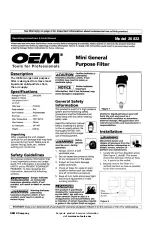
11
3. The Vulcan Technology
CO
2
+ H
2
O
H
2
CO
3
Carbon
dioxide
Water
Carbonic
acid
Separation of Ca(HCO
3
)
Ca(HCO
3
)
2
+
Vulcan
CaCo
3
+
CO
2
+
H
2
O
Calcium hydro-
gen carbonate-
Vulcan
impulse
Mono-
crystal
Carbon
dioxide
Water
This is the birth of the calcium mono-crystal, which can only grow into
two opposite directions and can therefore not cluster together with other
mono-crystals to form scale deposits. The mono-calcium-crystal forms
in a rod shape (pic. 3) between one end (+) and the other end (-).
In this form they can no longer stick together and forms deposits. During
its journey in the pipe system it will grow in size. The longer the mono-
crystal, the better the effect of the treatment.
The separation of the water components due to the electrophoresis also
changes the balance of calcium and carbonic acid, which creates a slight
surplus of carbonic acid (formula 2). This small rise in free carbonic acid
helps the cleaning of already existing scale deposits.
b) Separation of Ca(HCO
3
)
2
by overtone treatment
The Vulcan impulse treatment controls the creation of overtones as a
result of overlapping frequencies. The overtones are set to meet the
characteristics of a water cluster which is basically the smallest entity of
water. The extreme short wave lengths of the overtone parallels that of
the water cluster to the extent that the two begin resonating with each
other. Just as a high-pitch tone can burst a wine glass if it resonates
with the glass, matching the wave-length of the overtone with the water
cluster achieves the same result: the water cluster bursts.
When a water cluster bursts the same process of separation of the
Ca(HCO
3
)
2
components happens (compare formula 1). The stronger this
effect, the more the mono-crystals grow, which results in the desired
effect of scale and rust dismantling.
Mono-crystals and carbonic acid
Both the controlled electrophoresis (a.) and the overtone-
treatment (b.) result in separating the liquid calcium [Ca(CO
3
)
2
]
into its individual substances.
This way, Vulcan generates the rare
mono-crystals and a higher level of carbonic acid.
• The mono-crystals stop scale building up on surfaces
• Carbonic acid is the key ingredient to dismantling already existing
scale deposits.
overtones
pic. 3
As opposed to the typically chaotic clustered
calcium-crystal (a), the treated crystal forms
as well ordered mono-crystal (b) (the so called
aragonit shape) that is stream-lined between the
one end (+) and the other end (-).
Mono-crystals CaCo
3
Untreated crystals
+
–
small
–
+
+ –
medium
–
+
–
–
+
+
large
Formula 1
Formula 2
(a)
(b)
















































